Controls on Reservoirs Quality of the Upper Jurassic Mengyin Formation Sandstones in Dongying Depression, Bohai Bay Basin, Eastern China
Abstract
1. Introduction
2. Geological Setting
2.1. Regional Geology
2.2. Stratigraphy and Depositional Facies
3. Material and Methods
4. Results
4.1. Mineralogical Composition and Textures of Sandstones
4.2. Petrographic Features and Diagenesis
4.2.1. Compaction
4.2.2. Cementation
4.2.3. Dissolution
4.3. Macroscopic Petrophysical Properties
4.4. Pore Systems
5. Discussion and Interpretation
5.1. Diagenetic Evolution Sequence
5.1.1. Early Burial Phase
5.1.2. Uplift and Meteoric Flushing Phase
5.1.3. Stable Reburial Phase
5.1.4. Diagenetic Alteration Relations and Burial History Curve
5.2. Relationship between Compaction and Porosity under High Geothermal Gradient
5.3. Uncomformity and Its Effect on the Reservoir Quality
5.4. Fault Activity and Its Controls on Hydrocarbon Distribution
6. Conclusions
Author Contributions
Funding
Conflicts of Interest
References
- Ajdukiewicz, J.M.; Lander, R.H. Sandstone reservoir quality prediction: The state of the art. AAPG Bull. 2010, 94, 1083–1091. [Google Scholar] [CrossRef]
- Taylor, T.R.; Giles, M.R.; Hathon, L.A.; Diggs, T.N.; Braunsdorf, N.R.; Birbiglia, G.V.; Kittridge, M.G.; Macaulay, C.I.; Espejo, I.S. Sandstone diagenesis and reservoir quality prediction: Models, myths, and reality. Am. Assoc. Petroleum Geol. Bull. 2010, 94, 1093–1132. [Google Scholar] [CrossRef]
- Morad, S.; Al-Aasm, I.S.; Nader, F.H.; Ceriani, A.; Gasparrini, M.; Mansurbeg, H. Impact of diagenesis on the spatial and temporal distribution of reservoir quality in the Jurassic Arab D and C members, offshore Abu Dhabi oilfield, United Arab Emirates. GeoArabia 2012, 17, 17–56. [Google Scholar]
- Yuan, G.; Cao, Y.; Gluyas, J.; Li, X.; Xi, K.; Wang, Y.; Jia, Z.; Sun, P.; Oxtoby, N.H. Feldspar dissolution, authigenic clays, and quartz cements in open and closed sandstone geochemical systems during diagenesis: Typical examples from two sags in Bohai Bay Basin, East China. AAPG Bull. 2015, 99, 2121–2154. [Google Scholar] [CrossRef]
- Yuan, G.; Gluyas, J.; Cao, Y.; Oxtoby, N.H.; Jia, Z.; Wang, Y.; Li, X. Diagenesis and reservoir quality evolution of the Eocene sandstones in the northern Dongying Sag, Bohai Bay Basin, East China. Mar. Pet. Geol. 2015, 62, 77–89. [Google Scholar] [CrossRef]
- Xi, K.; Cao, Y.; Jahren, J.; Zhu, R.; Bjørlykke, K.; Haile, B.G.; Zheng, L.; Hellevang, H. Diagenesis and reservoir quality of the Lower Cretaceous Quantou Formation tight sandstones in the southern Songliao Basin, China. Sediment. Geol. 2015, 330, 90–107. [Google Scholar] [CrossRef]
- Perri, F.; Cirrincione, R.; Critelli, S.; Mazzoleni, P.; Pappalardo, A. Clay mineral assemblages and sandstone compositions of the Mesozoic Longobucco Group (north-eastern Calabria): Implication for burial history and diagenetic evolution. Int. Geol. Rev. 2008, 50, 1116–1131. [Google Scholar] [CrossRef]
- Luo, J.L.; Morad, S.; Salem, A.; Ketzer, J.M.; Lei, X.L.; Guo, D.Y.; Hlal, O. Impact of diagenesis on reservoir-quality evolution in fluvial and lacustrine-deltaic sandstones: Evidence from Jurassic and Triassic sandstones from the ordos basin, China. J. Pet. Geol. 2009, 32, 79–102. [Google Scholar] [CrossRef]
- Morad, S.; Al-Ramadan, K.; Ketzer, J.M.; De Ros, L.F. The impact of diagenesis on the heterogeneity of sandstone reservoirs: A review of the role of depositional facies and sequence stratigraphy. AAPG Bull. 2010, 94, 1267–1309. [Google Scholar] [CrossRef]
- Guo, X.; Liu, K.; He, S.; Song, G.; Wang, Y.; Hao, X.; Wang, B. Petroleum generation and charge history of the northern Dongying depression, Bohai Bay Basin, China: Insight from integrated fluid inclusion analysis and basin modelling. Mar. Pet. Geol. 2012, 32, 21–35. [Google Scholar] [CrossRef]
- Guo, S.; Tan, L.; Lin, C.; Li, H.; Lü, X.; Wang, H. Hydrocarbon accumulation characteristics of beach-bar sandstones in the southern slope of the Dongying Sag, Jiyang Depression, Bohai Bay Basin, China. Pet. Sci. 2014, 11, 220–233. [Google Scholar] [CrossRef]
- Henares, S.; Caracciolo, L.; Cultrone, G.; Fernandez, J.; Viseras, C. The role of diagenesis and depositional facies on pore system evolution in a triassic outcrop analogue (SE Spain). Mar. Pet. Geol. 2014, 51, 136–151. [Google Scholar] [CrossRef]
- Zhang, H.; Zhang, R.; Yang, H.; Shou, J.; Wang, J.; Liu, C.; Chen, G. Characterization and evaluation of ultra-deep fracture-pore tight sandstone re- servoirs: A case study of Cretaceous Bashijiqike Formation in Kelasu tectonic zone in Kuqa foreland basin, Tarim, NW China. Pet. Explor. Dev. 2014, 41, 158–167. [Google Scholar] [CrossRef]
- Zhou, Y.; Ji, Y.; Zhang, S.; Wan, L. Controls on reservoir quality of Lower Cretaceous tight sandstones in the Laiyang Sag, Jiaolai Basin, eastern China: Integrated sedimentologic, diagenetic and microfracturing data. Mar. Pet. Geol. 2016, 76, 26–50. [Google Scholar] [CrossRef]
- Lai, J.; Wang, G.; Wang, S.; Cao, J.; Li, M.; Pang, X.; Zhou, Z.; Fan, X.; Dai, Q.; Yang, L.; et al. Review of diagenetic facies in tight sandstones: Diagenesis, diagenetic minerals, and prediction via well logs. Earth Sci. Rev. 2018, 185, 234–258. [Google Scholar] [CrossRef]
- Nabawy, B.S.; Géraud, Y. Impacts of pore-and petro-fabrics, mineral composition and diagenetic history on the bulk thermal conductivity of sandstones. J. Afr. Earth Sci. 2015, 115, 21–24. [Google Scholar] [CrossRef]
- Cook, J.E.; Goodwin, L.B.; Boutt, D.F. Systematic diagenetic changes in the grain-scale morphology and permeability of a quartz-cemented quartz arenite. AAPG Bull. 2011, 95, 1067–1088. [Google Scholar] [CrossRef]
- Mozley, P.S.; Heath, J.E.; Dewers, T.A.; Bauer, S.J. Origin and heterogeneity of pore sizes in the Mount Simon sandstone and Eau Claire formation: Implications for multiphase fluid flow. Geosphere 2016, 12, 1341–1361. [Google Scholar] [CrossRef]
- Bjorlykke, K.; Jahren, J. Open or closed geochemical systems during diagenesis in sedimentary basins: Constraints on mass transfer during diagenesis and the prediction of porosity in sandstone and carbonate reservoirs. AAPG Bull. 2012, 96, 2193–2214. [Google Scholar] [CrossRef]
- Bjørlykke, K. Relationships between depositional environments, burial history and rock properties. Some principal aspects of diagenetic process in sedimentary basins. Sediment. Geol. 2014, 301, 1–14. [Google Scholar] [CrossRef]
- Higgs, K.E.; Crouch, E.M.; Raine, J.I. An interdisciplinary approach to reservoir characterization: An example from the early to middle eocene kaimiro formation, taranaki basin, New Zealand. Mar. Pet. Geol. 2017, 86, 111–139. [Google Scholar] [CrossRef]
- Wang, J.; Cao, Y.; Liu, K.; Liu, J.; Xue, X.; Xu, Q. Pore fluid evolution, distribution and water-rock interactions of carbonate cements in red-bed sandstone reservoirs in the Dongying Depression, China. Mar. Pet. Geol. 2016, 72, 279–294. [Google Scholar] [CrossRef]
- Wang, Y.; Yang, S.; Lu, Y.; Ma, B.; Zhao, Y.; Wang, Y. Characteristics and controlling factors of effective reservoirs of mesozoic low-permeability clastic rocks in Gaoqing region, Dongying depression, Bohai Bay basin, China. Oil Gas Geol. 2019, 40, 271–283, (In Chinese with English Abstract). [Google Scholar]
- Henares, S.; Caracciolo, L.; Viseras, C.; Fernandez, J.; Yeste, L.M. Diagenetic constraints on heterogeneous reservoir quality assessment: A Triassic outcrop analog of meandering fluvial reservoirs. AAPG Bull. 2016, 100, 1377–1398. [Google Scholar] [CrossRef]
- Gier, S.; Worden, R.H.; Johns, W.D.; Kurzweil, H. Diagenesis and reservoir quality of Miocene sandstones in the Vienna Basin, Austria. Mar. Pet. Geol. 2008, 25, 681–695. [Google Scholar] [CrossRef]
- Rustichelli, A.; Tondi, E.; Agosta, F.; Di Celma, C.; Giorgioni, M. Sedimentologic and diagenetic controls on pore-network characteristics of Oligocenee-Miocene ramp carbonates (Majella Mountain, central Italy). AAPG Bull. 2013, 97, 487–524. [Google Scholar] [CrossRef]
- Rossi, C.; Marfil, R.; Ramseyer, K.; Permanyer, A. Facies-related diagenesis and multiphase siderite cementation and dissolution in the reservoir sandstones of the Khatatba Formation, Egypt’s Western Desert. J. Sediment. Res. 2001, 71, 459–472. [Google Scholar] [CrossRef]
- Mansurbeg, H.; De Ros, L.F.; Morad, S.; Ketzer, J.M.; El-Ghali, M.A.K.; Caja, M.A.; Othman, R. Meteoric-water diagenesis in late Cretaceous canyon-fill turbidite reservoirs from the Espírito Santo Basin, eastern Brazil. Mar. Pet. Geol. 2012, 37, 7–26. [Google Scholar] [CrossRef]
- Yuan, G.; Cao, Y.; Zhang, Y.; Zhang, Y.; Gluyas, J. Diagenesis and reservoir quality of sandstones with ancient “deep” incursion of meteoric freshwater—An example in the Nanpu sag, Bohai Bay Basin, East China. Mar. Pet. Geol. 2017, 82, 444–464. [Google Scholar] [CrossRef]
- Chen, C.; Huang, J.; Chen, J.; Tian, X. Depositional models of Tertiary rift basins, eastern China, and their application to petroleum prediction. Sediment. Geol. 1984, 40, 73–88. [Google Scholar]
- Desheng, L. Geologic evolution of petroliferous basins on continental shelf of China. AAPG Bull. 1984, 68, 993–1003. [Google Scholar]
- Zahid, M.A.; Chunmei, D.; Lin, C.; Gluyas, J.; Jones, S.; Zhang, X.; Muhammad, J.M.; Ma, C. Sequence stratigraphy, sedimentary facies and reservoir quality of es4s, southern slope of Dongying Depression, Bohai Bay Basin, East china. Mar. Pet. Geol. 2016, 77, 448–470. [Google Scholar] [CrossRef]
- Cao, Y.; Yuan, G.; Li, X.; Wang, Y.; Xi, K.; Wang, X.; Jia, Z.; Yang, T. Characteristics and origin of abnormally high porosity zones in buried Paleogene clastic reservoirs in the Shengtuo area, Dongying Sag, East China. Pet. Sci. 2014, 11, 346–362. [Google Scholar] [CrossRef]
- Wang, B.; Luo, S.; Chen, Y.; Wu, W. Numerical simulation of hydrocarbon generation, migration and accumulation in the boxing sag, Dongying Depression, Jiyang Subbasin. Oil Gas Geol. 2012, 33, 675–685, (In Chinese with English Abstract). [Google Scholar]
- Shen, B.; Huang, Z.; Liu, H.; Xu, C.; Yan, Z.; Chen, M. Geochemistry and origin of gas pools in the Gaoqing-Pingnan fault zone, Jiyang Depression. Chin. J. Geochem. 2007, 26, 446–454. [Google Scholar] [CrossRef]
- Zhang, J.F.; Zhang, F.; Wu, H.; Xiang, X. Relationships between different strike activities of gaoqing fault and huagou gas reservoirs accumulation, jiyang depression. Nat. Gas Geosci. 2008, 19, 356–361, (In Chinese with English Abstract). [Google Scholar]
- Wang, Y.; Yang, S.; Lu, Y.; Wang, X.; Ma, B.; Zhao, Y. Evaluation method of low permeability reservoirs based on logging petrophysical facies identification: A case study of the upper member of Mengyin formation in Gaoqing area, Dongying depression. J. China Univ. Min. Technol. 2018, 47, 1264–1275, (In Chinese with English Abstract). [Google Scholar]
- Boggs, S. Principles of Sedimentology and Stratigraphy; Pearson Prentice Hall: Upper Saddle River, NJ, USA, 2006. [Google Scholar]
- Bodnar, R.J. Revised equation and table for determining the freezing point depression of H2o-NaCl solutions. Geochim. Cosmochim. Acta 1993, 57, 683–684. [Google Scholar] [CrossRef]
- Folk, R.L. Petrology of Sedimentary Rocks; Hemphill Book Store: Hemphill, TX, USA, 1968; p. 170. [Google Scholar]
- Anovitz, L.M.; Cole, D.R.; Rother, G.; Allard, L.F.; Jackson, A.J.; Littrell, K.C. Diagenetic changes in macro- to nano-scale porosity in the St. Peter Sandstone: An (ultra) small angle neutron scattering and backscattered electron imaging analysis. Geochim. Cosmochim. Acta 2013, 102, 280–305. [Google Scholar] [CrossRef]
- Anovitz, L.M.; Cole, D.R.; Jackson, A.J.; Rother, G.; Littrell, K.C.; Allard, L.F.; Pollington, A.D.; Wesolowski, D.J. Effect of quartz overgrowth precipitation on the multiscale porosity of sandstone: A (U)SANS and imaging analysis. Geochim. Cosmochim. Acta 2015, 153, 199–222. [Google Scholar] [CrossRef]
- Anovitz, L.M.; Cole, D.R. Characterization and analysis of porosity and pore structures. Rev. Mineral. Geochem. 2015, 80, 61–164. [Google Scholar] [CrossRef]
- Zou, C.; Zhu, R.; Liu, K.; Su, L.; Bai, B.; Zhang, X.; Yuan, X.; Wang, J. Tight gas sandstone reservoirs in China: Characteristics and recognition criteria. J. Pet. Sci. Eng. 2012, 88–89, 82–91. [Google Scholar] [CrossRef]
- Zhou, T.; Wu, C.; Shi, Z.; Wang, J.; Zhu, W.; Yuan, B.; Yang, D. Multi-Scale Quantitative Characterization of Pore Distribution Networks in Tight Sandstone by integrating FE-SEM, HPMI, and NMR with the Constrained Least Squares Algorithm. Energies 2019, 12, 3514. [Google Scholar] [CrossRef]
- Zhao, H.; Ning, Z.; Wang, Q.; Zhang, R.; Zhao, T.; Niu, T.; Zeng, Y. Petrophysical characterization of tight oil reservoirs using pressure-controlled porosimetry combined with rate-controlled porosimetry. Fuel 2015, 154, 233–242. [Google Scholar] [CrossRef]
- Xiao, D.; Lu, Z.; Jiang, S.; Lu, S. Comparison and integration of experimental methods to characterize the full-range pore features of tight gas sandstone—A case study in Songliao basin of China. J. Nat. Gas Sci. Eng. 2016, 34, 1412–1421. [Google Scholar] [CrossRef]
- Higgs, K.E.; Zwingmann, H.; Reyes, A.G.; Funnell, R.H. Diagenesis, porosity evolution, and petroleum emplacement in tight gas reservoirs, Taranaki basin, New Zealand. J. Sediment. Res. 2007, 77, 1003–1025. [Google Scholar] [CrossRef]
- Dutton, S.P.; Loucks, R.D. Diagenetic controls on evolution of porosity and permeability in lower Tertiary Wilcox sandstones from shallow to ultra-deep (200–6700 m) burial, Gulf of Mexico Basin, USA. Mar. Pet. Geol. 2010, 27, 69–81. [Google Scholar] [CrossRef]
- Houseknecht, D.W. Assessing the relative importance of compaction processes and cementation to reduction of porosity in sandstones. Am. Assoc. Petrol. Geol. Bull. 1987, 71, 633–642. [Google Scholar]
- Beard, C.; Weyl, P.K. Influence of texture on porosity and permeability of un- consolidated sand. Am. Assoc. Pet. Geol. Bull. 1973, 57, 349–369. [Google Scholar]
- English, K.L.; Redfern, J.; Corcoran, D.V.; English, J.M.; Yahia Cherif, R. Constraining burial history and petroleum charge in exhumed basins: New insights from the Illizi Basin. Am. Assoc. Petroleum Geol. Bull. 2016, 100, 623–655. [Google Scholar] [CrossRef]
- English, K.L.; English, J.M.; Bonnell, L.M.; Lander, R.H.; Hollis, C.; Redfern, J.; Guirdham, C.; Garnham, J.; Cherif, R.Y. Controls on reservoir quality in exhumed basins—an example from the ordovician sandstone, illizi basin, algeria. Mar. Pet. Geol. 2017, 80, 203–227. [Google Scholar] [CrossRef]
- Saïag, J.; Brigaud, B.; Portier, É.; Desaubliaux, G.; Bucherie, A.; Miska, S.; Pagel, M. Sedimentological control on the diagenesis and reservoir quality of tidal sandstones of the Upper Cape Hay formation (Permian, Bonaparte basin, Australia). Mar. Mar. Pet. Geol. 2016, 77, 597–624. [Google Scholar] [CrossRef]
- Jiang, Z.; Pang, X.; Jin, Z.; Guan, D.; Li, Y. Relationship between pore variation of reservoir and rebounding of sandstone during uplift and its application to the Daqing Oilfield. Earth Science: J. China Univ. Geosci. 2004, 29, 420–426, (In Chinese with English Abstract). [Google Scholar]
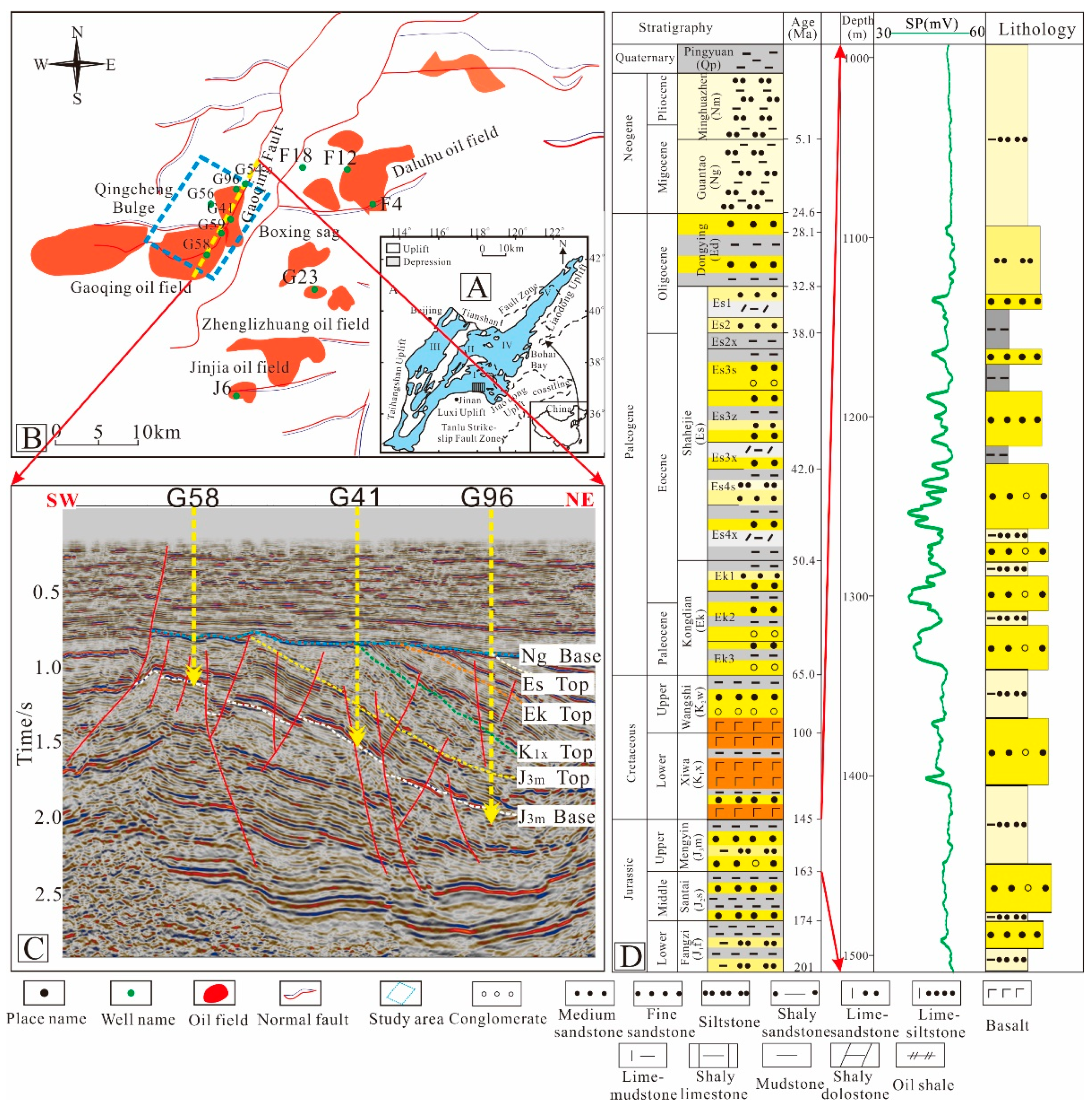
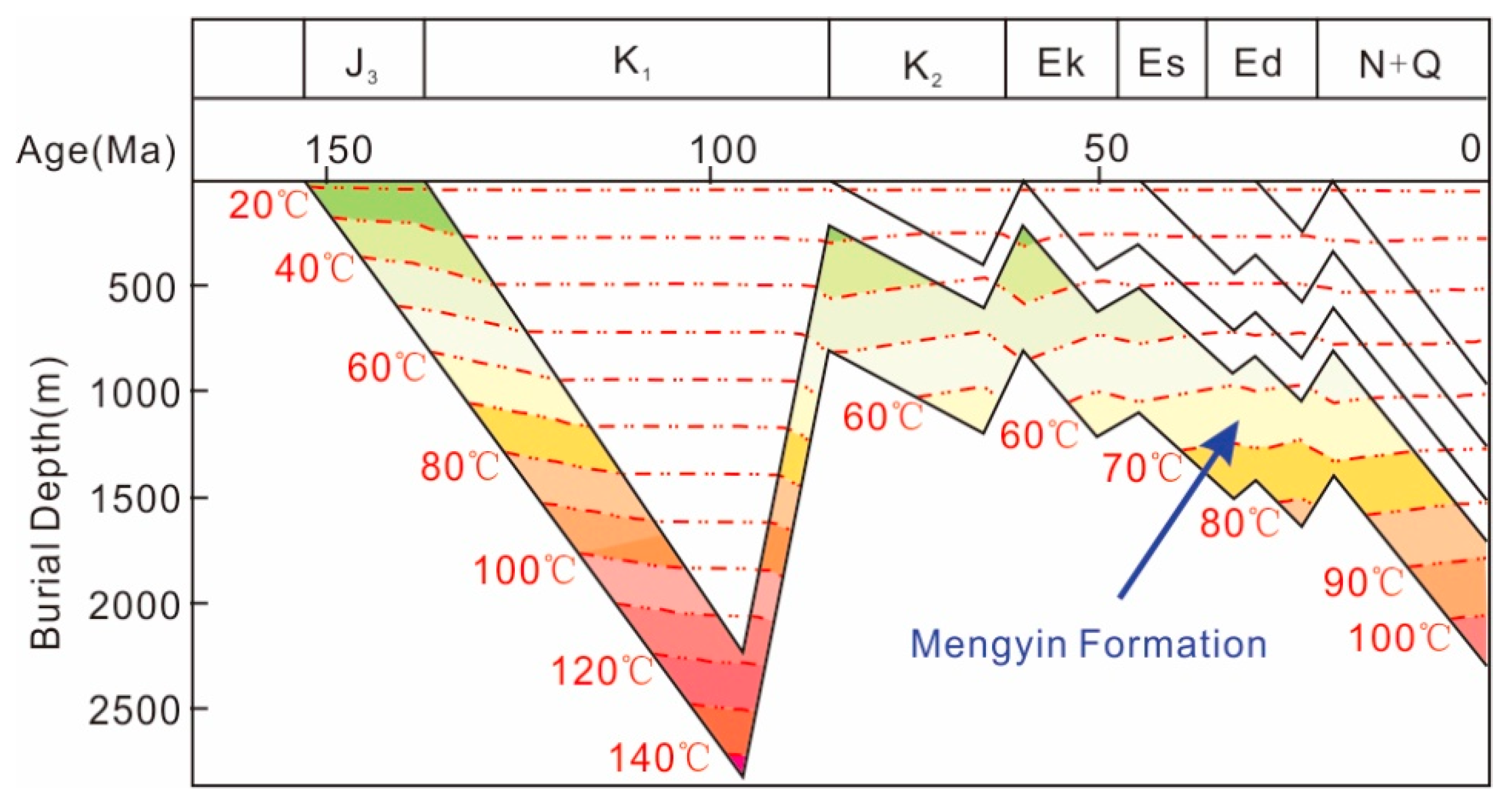
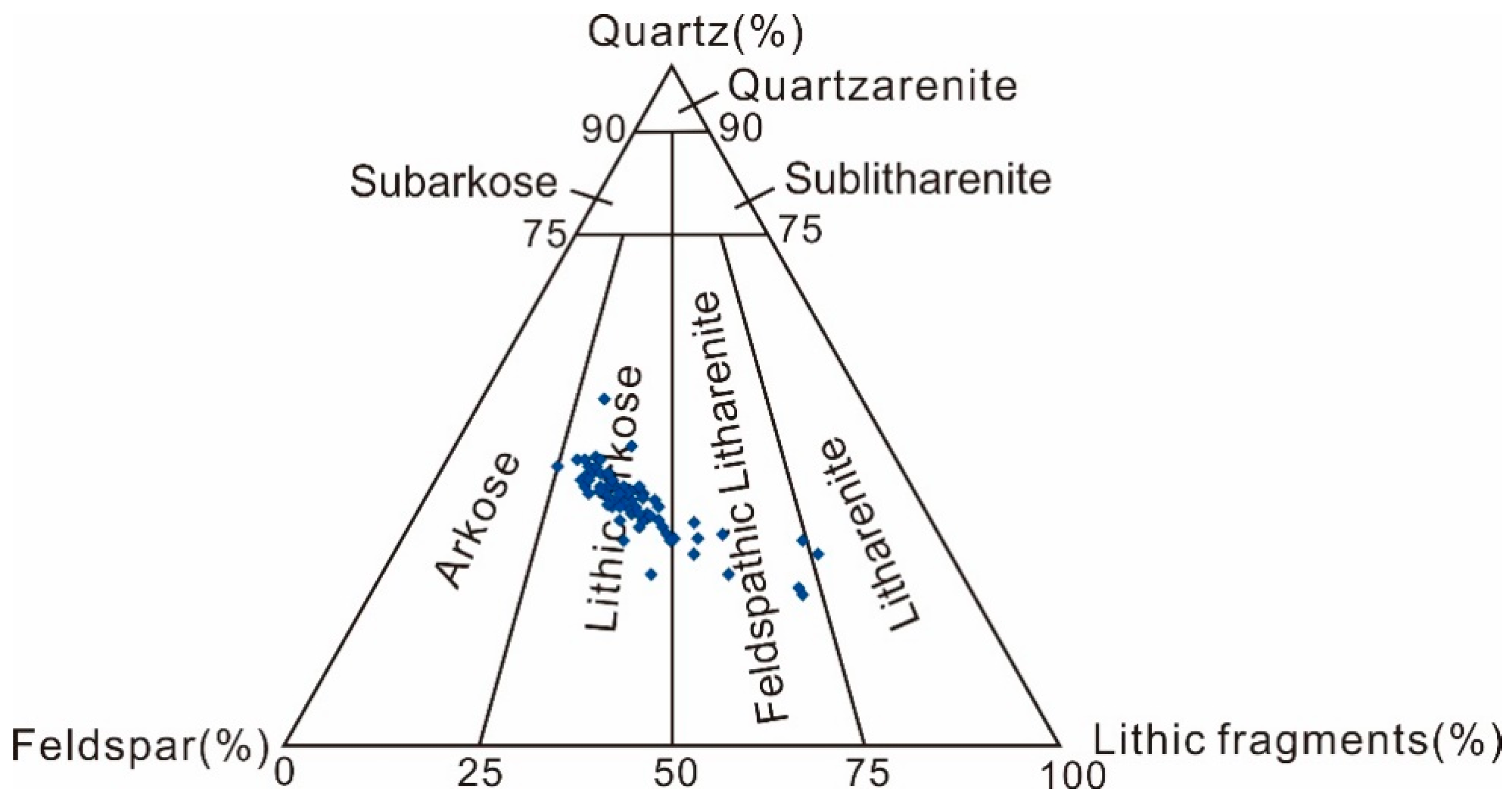
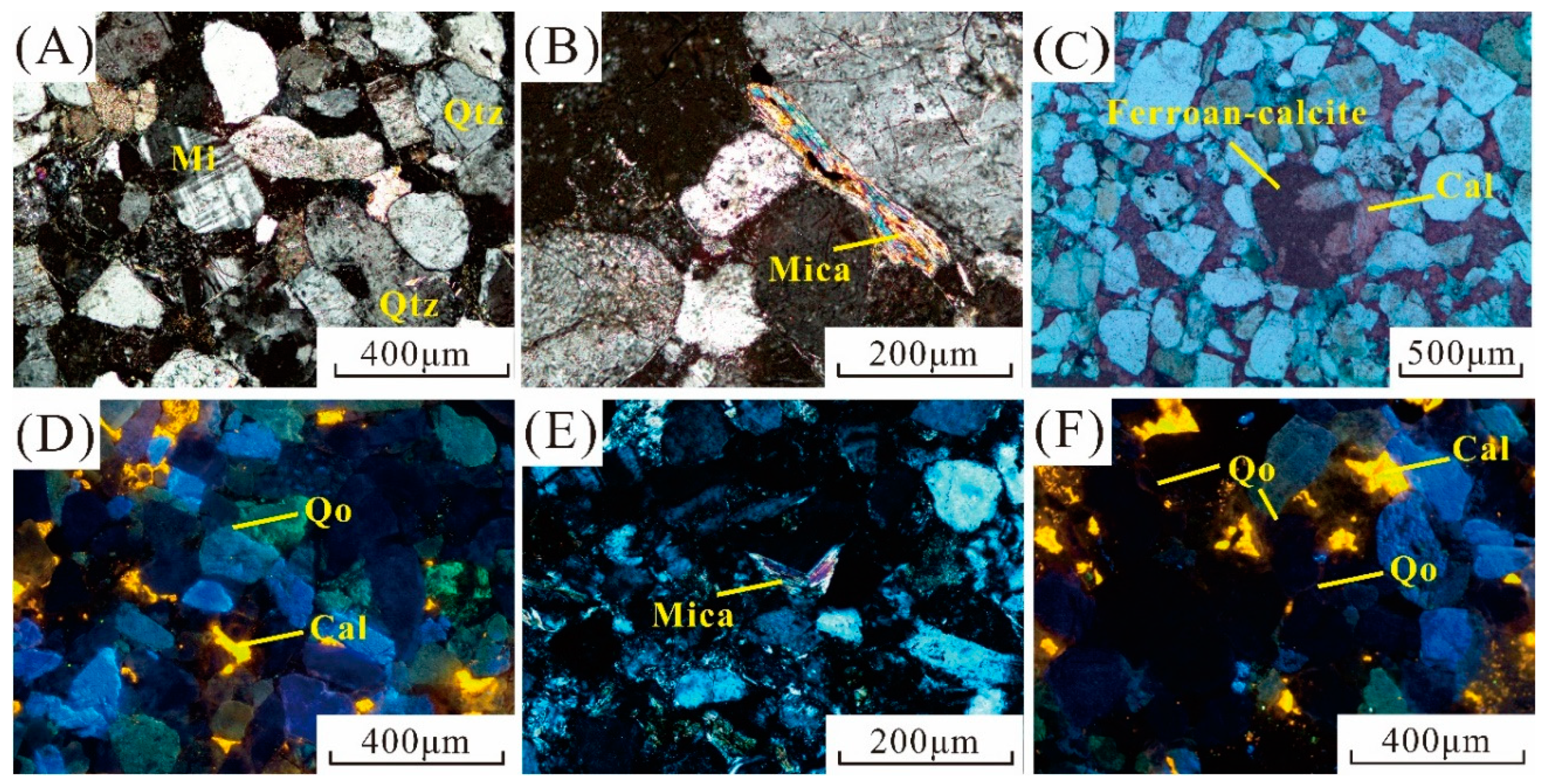
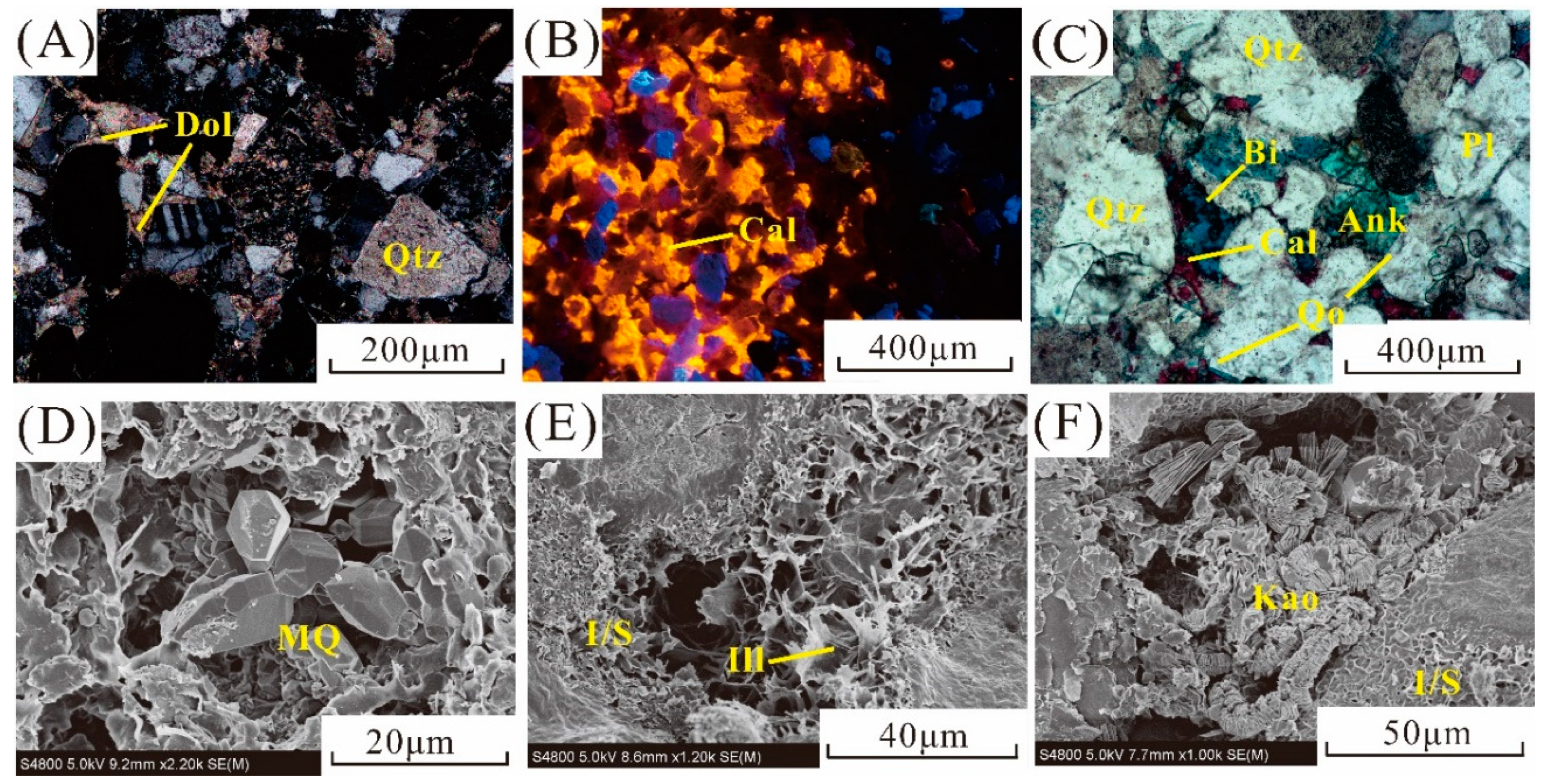
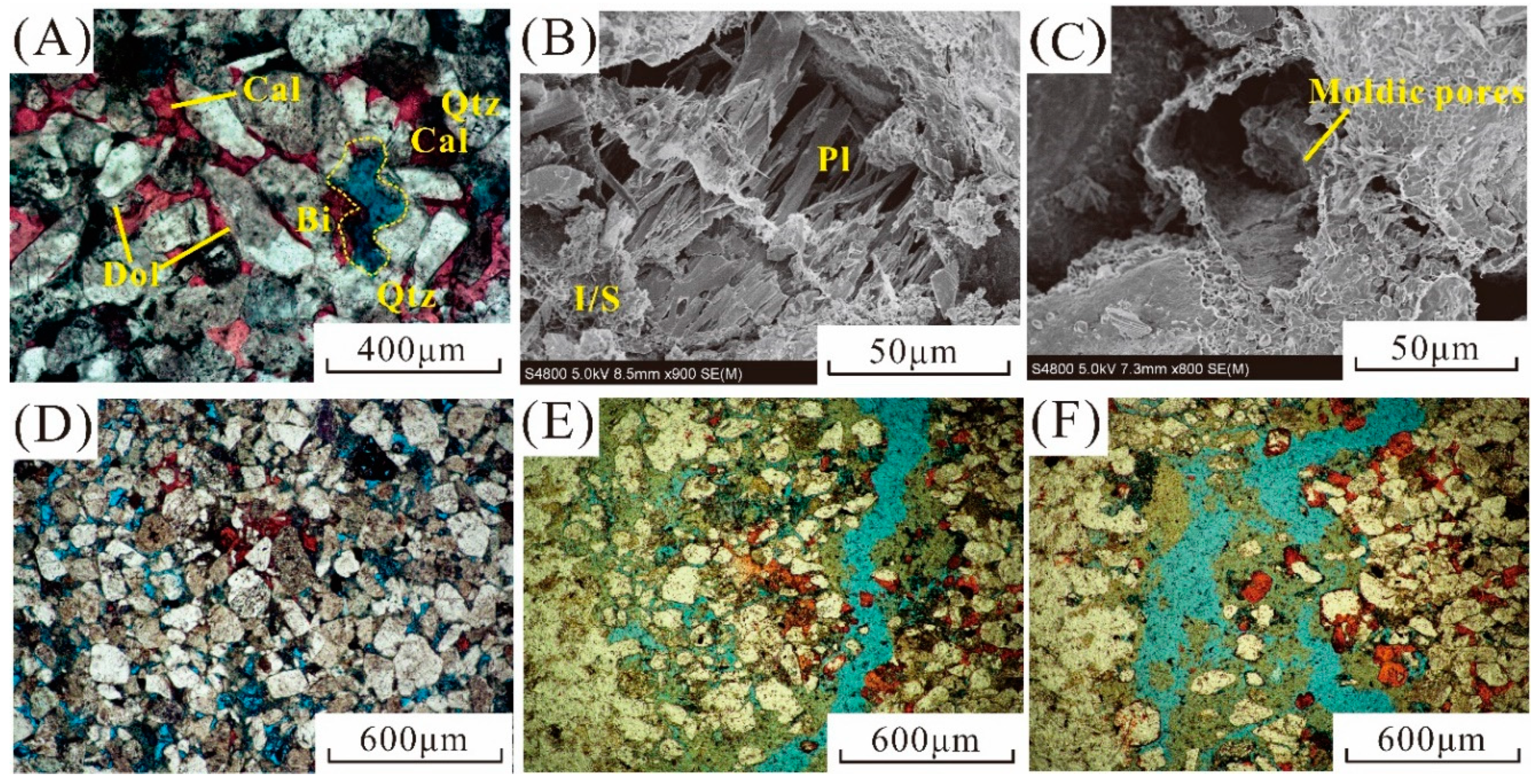
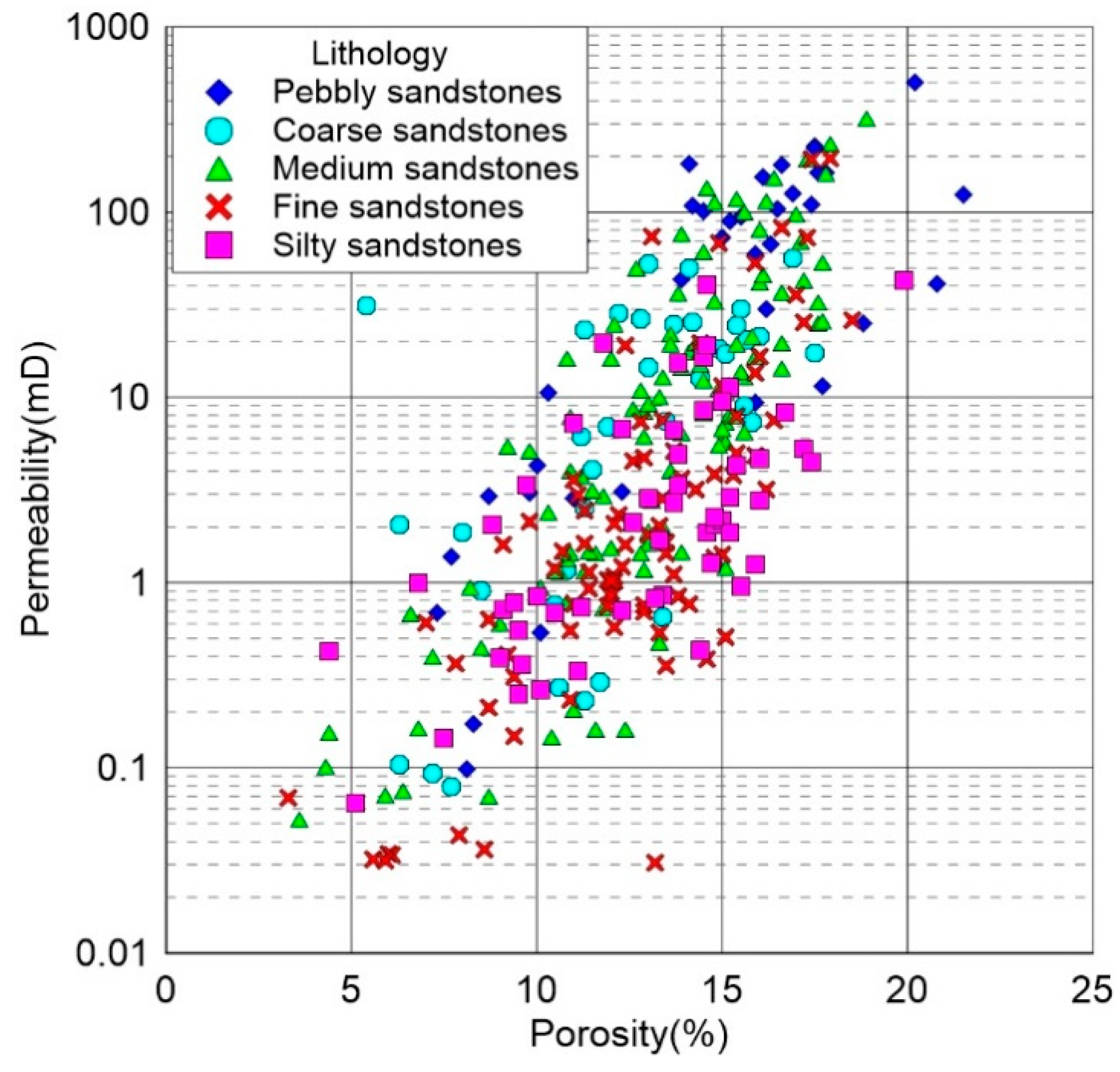
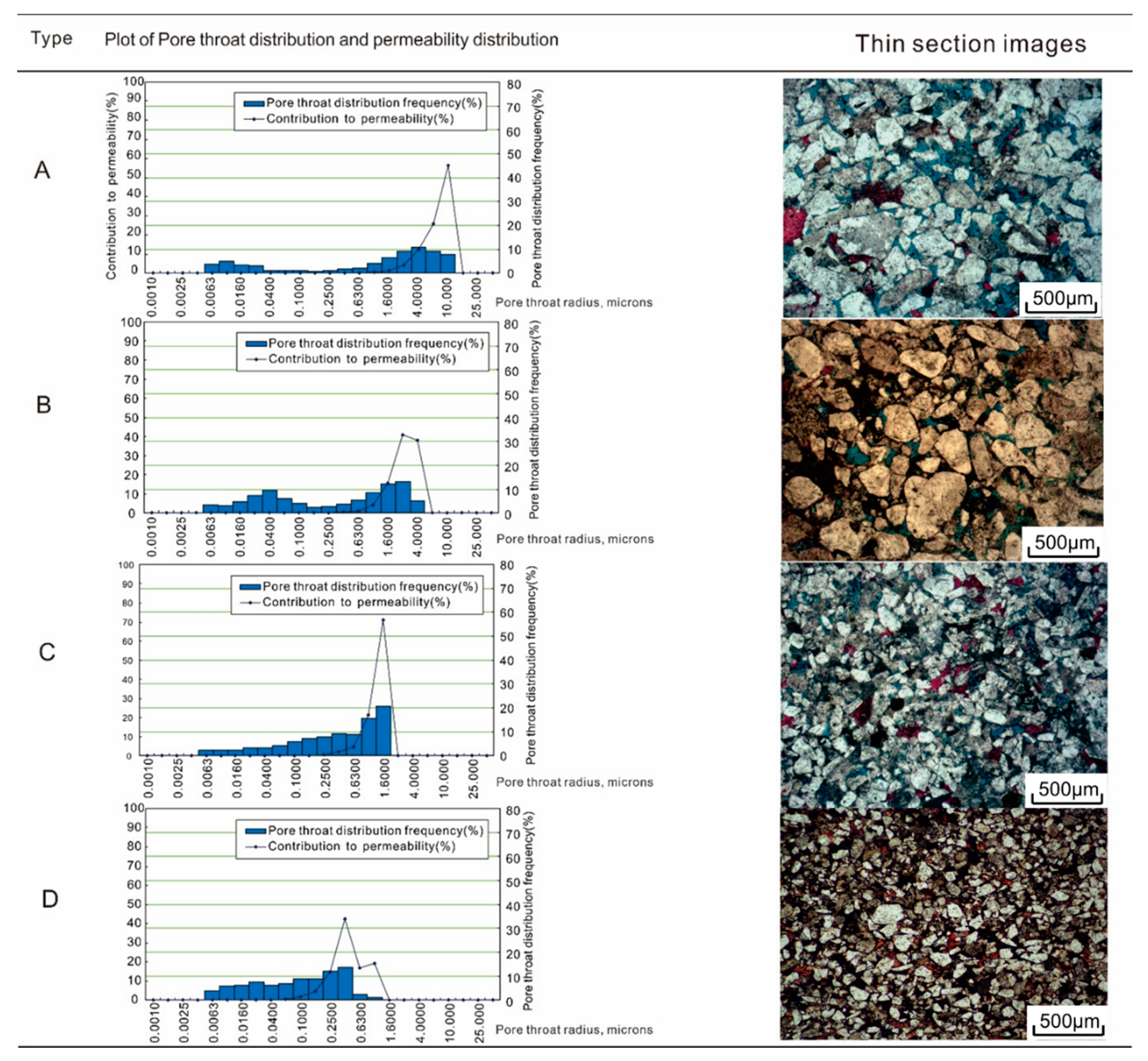
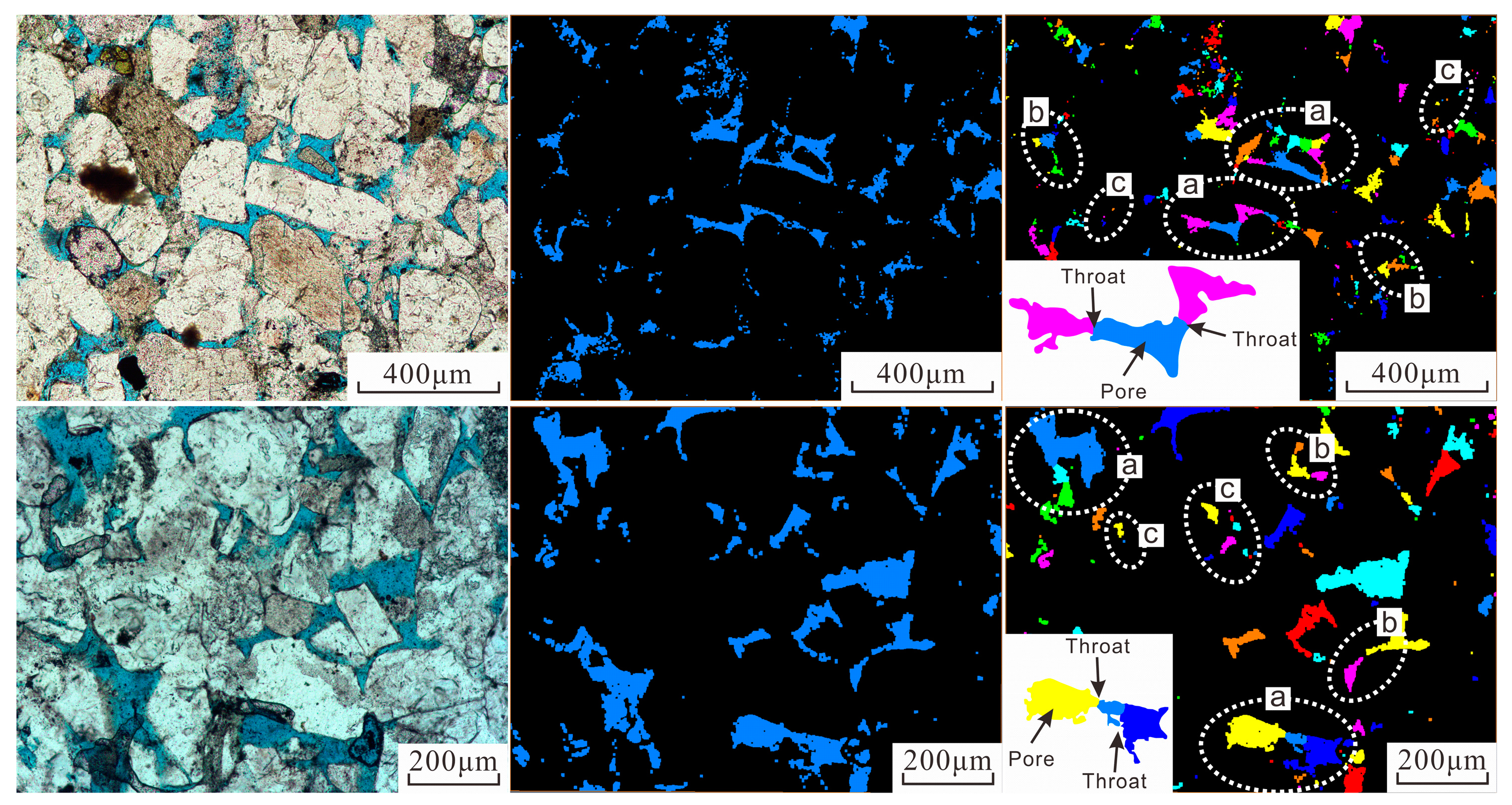

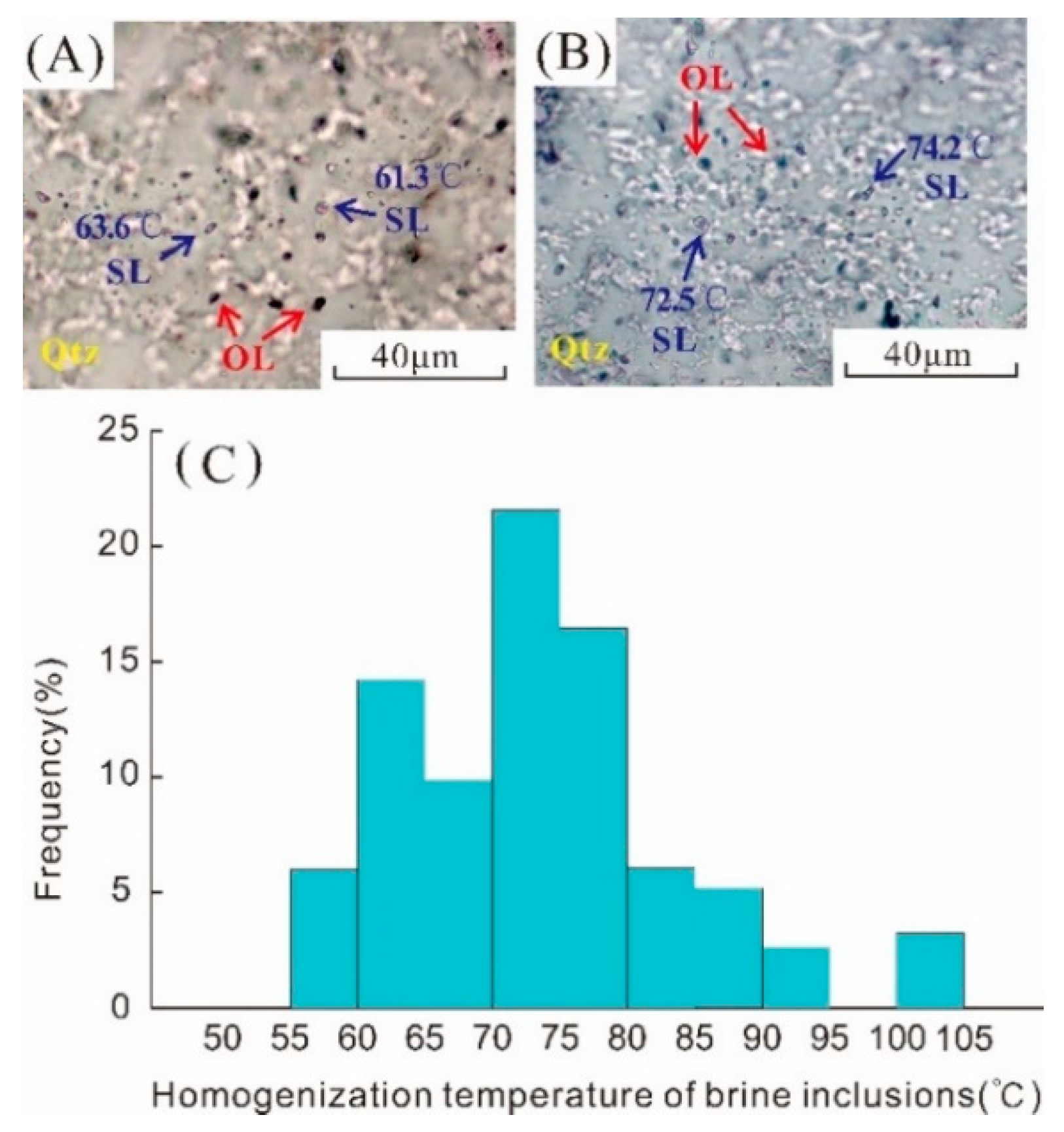
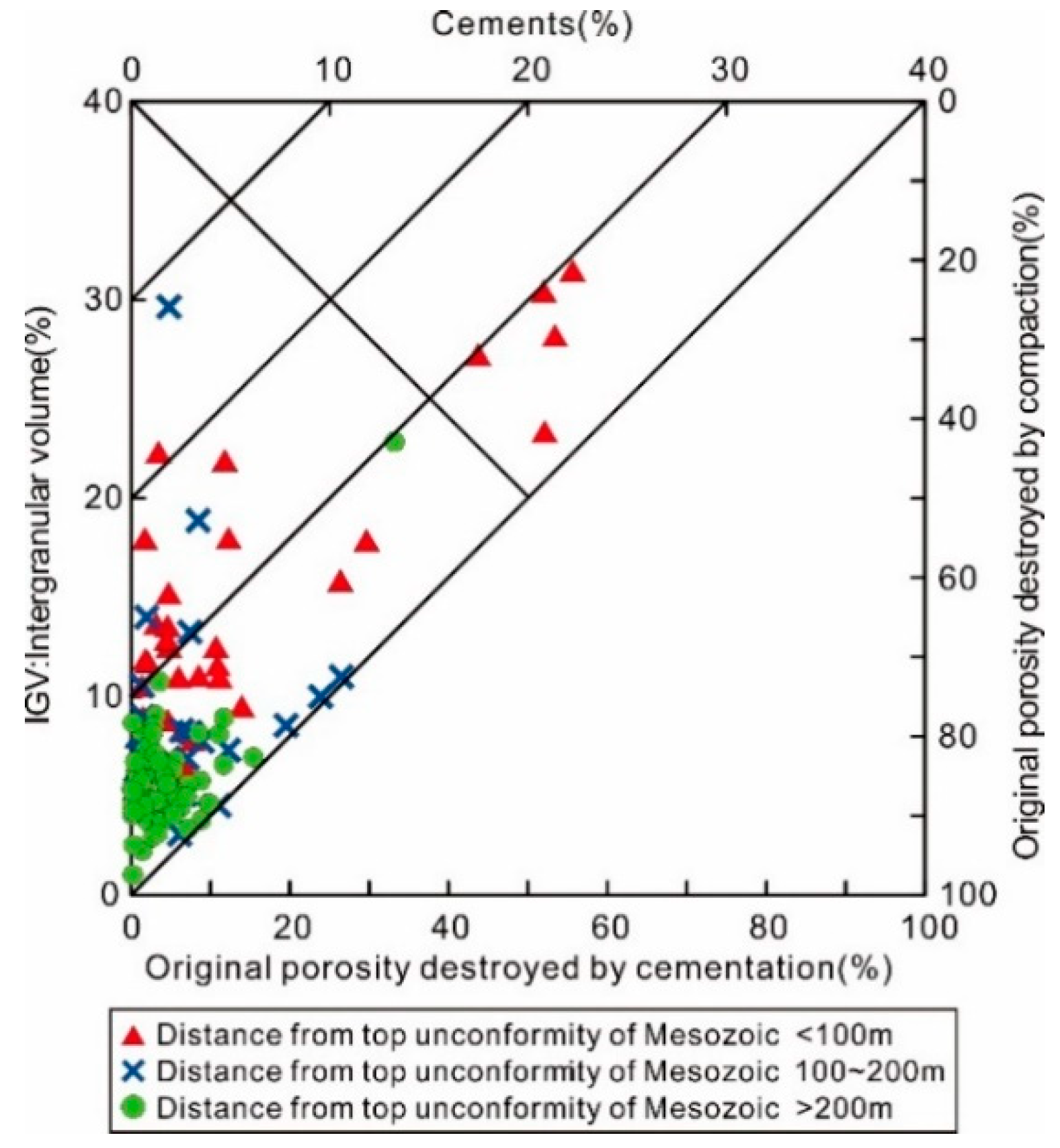
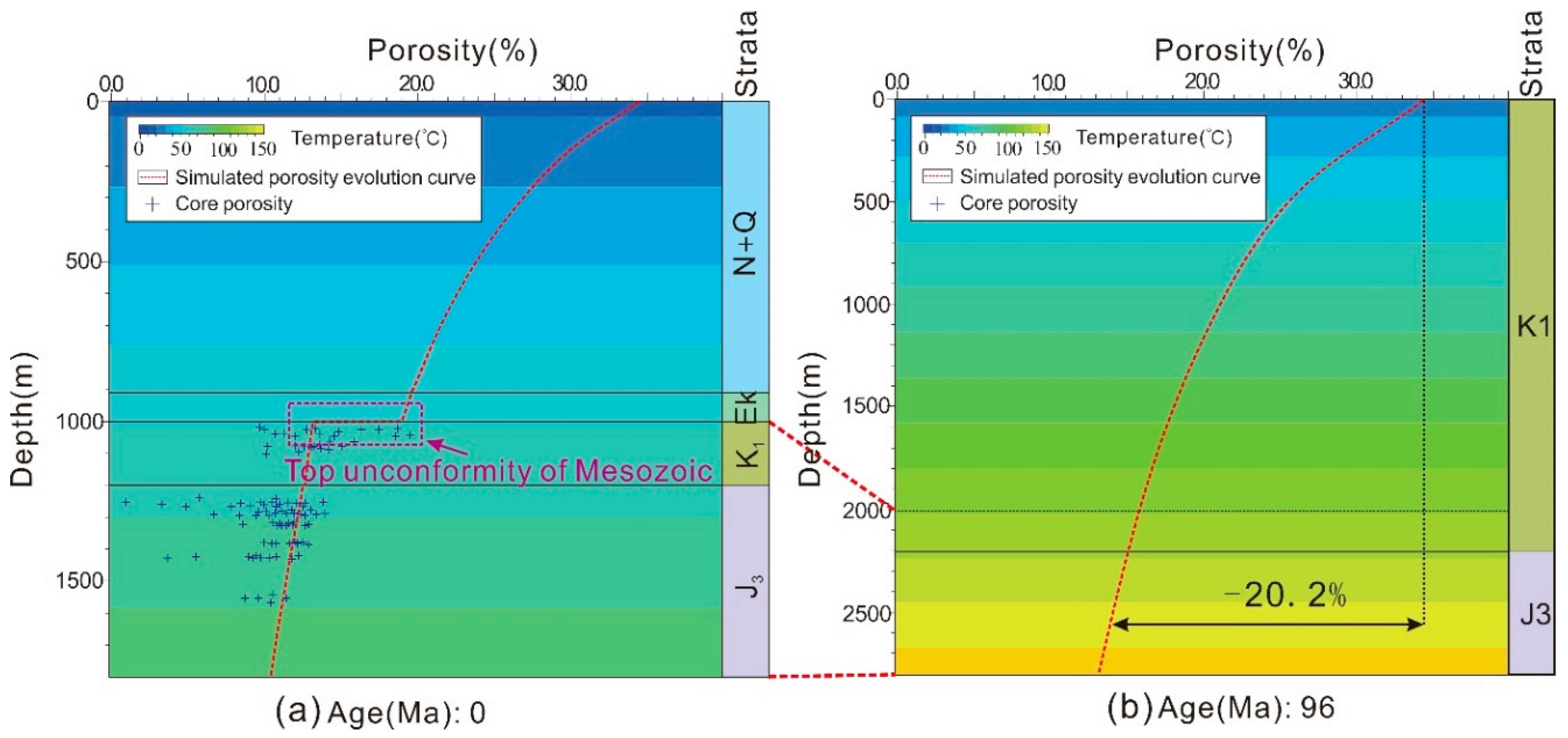
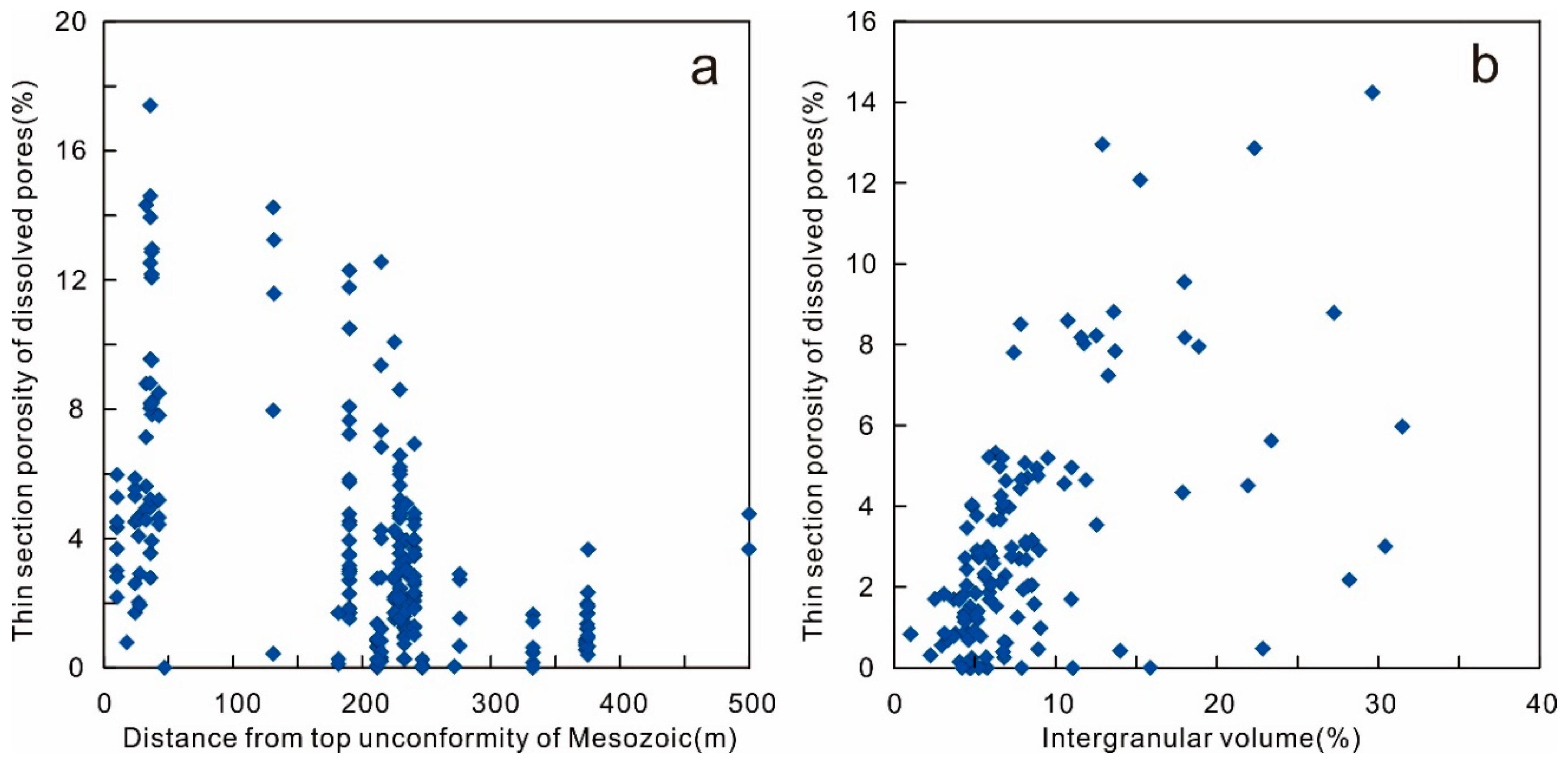
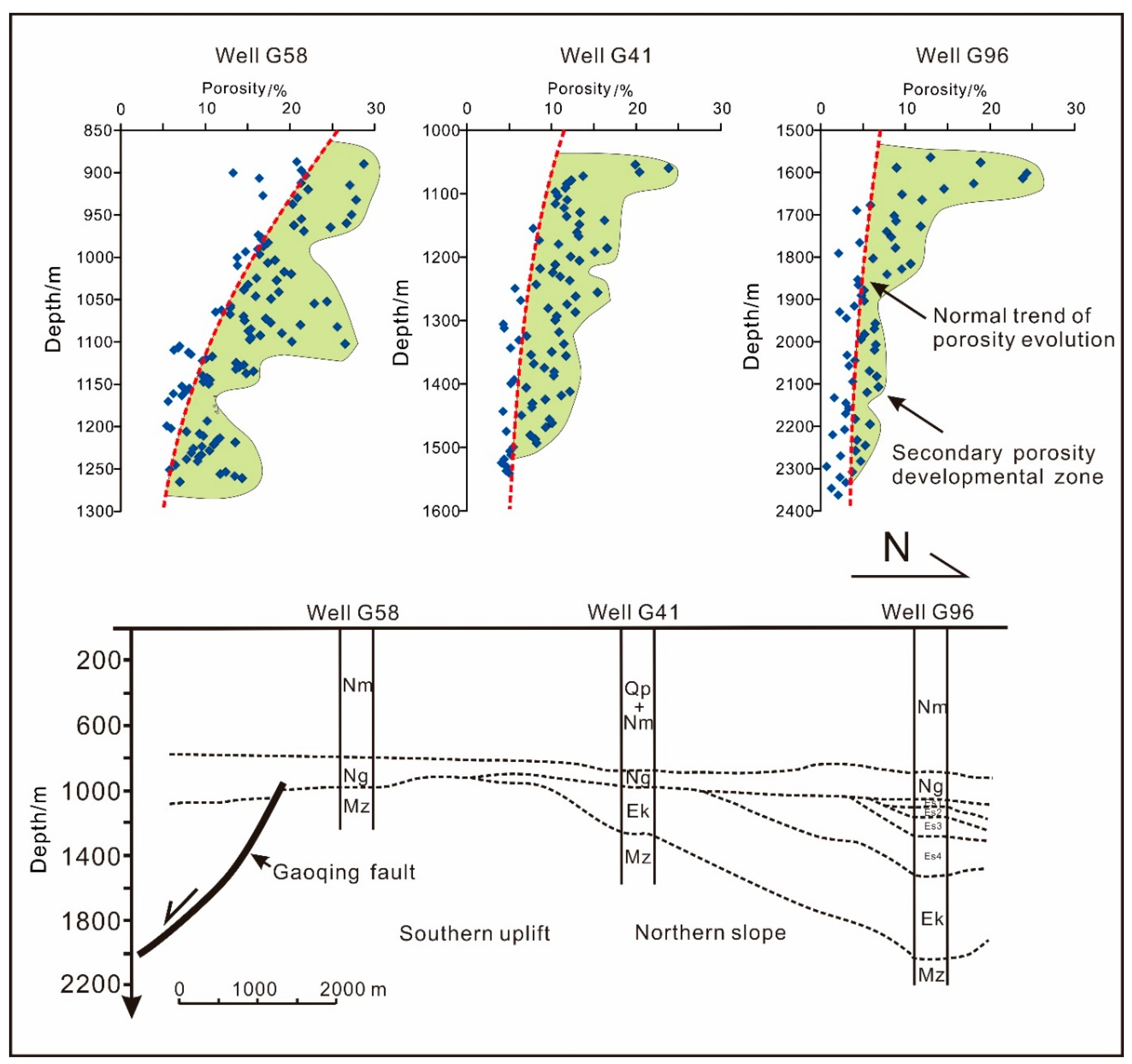
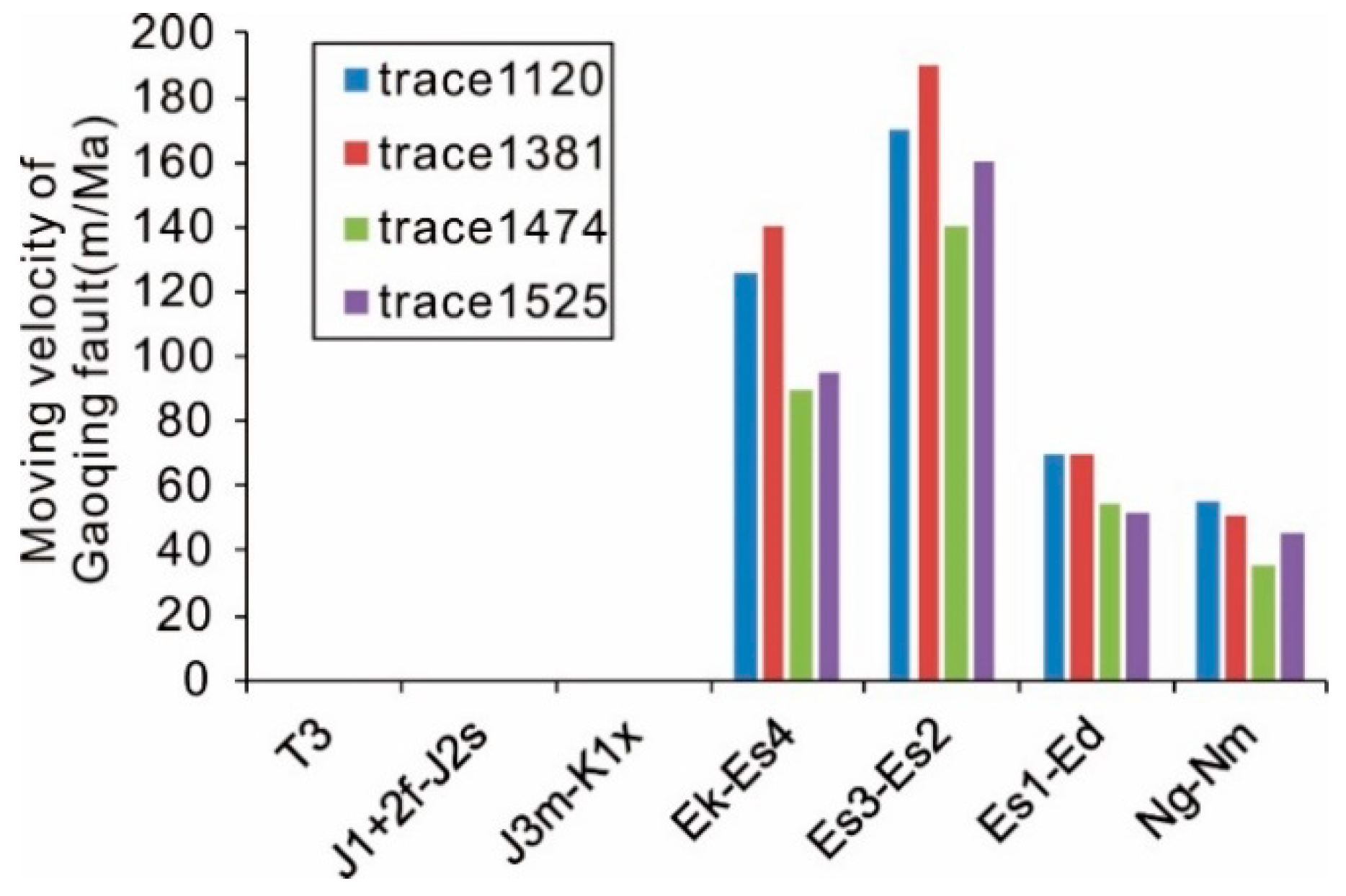
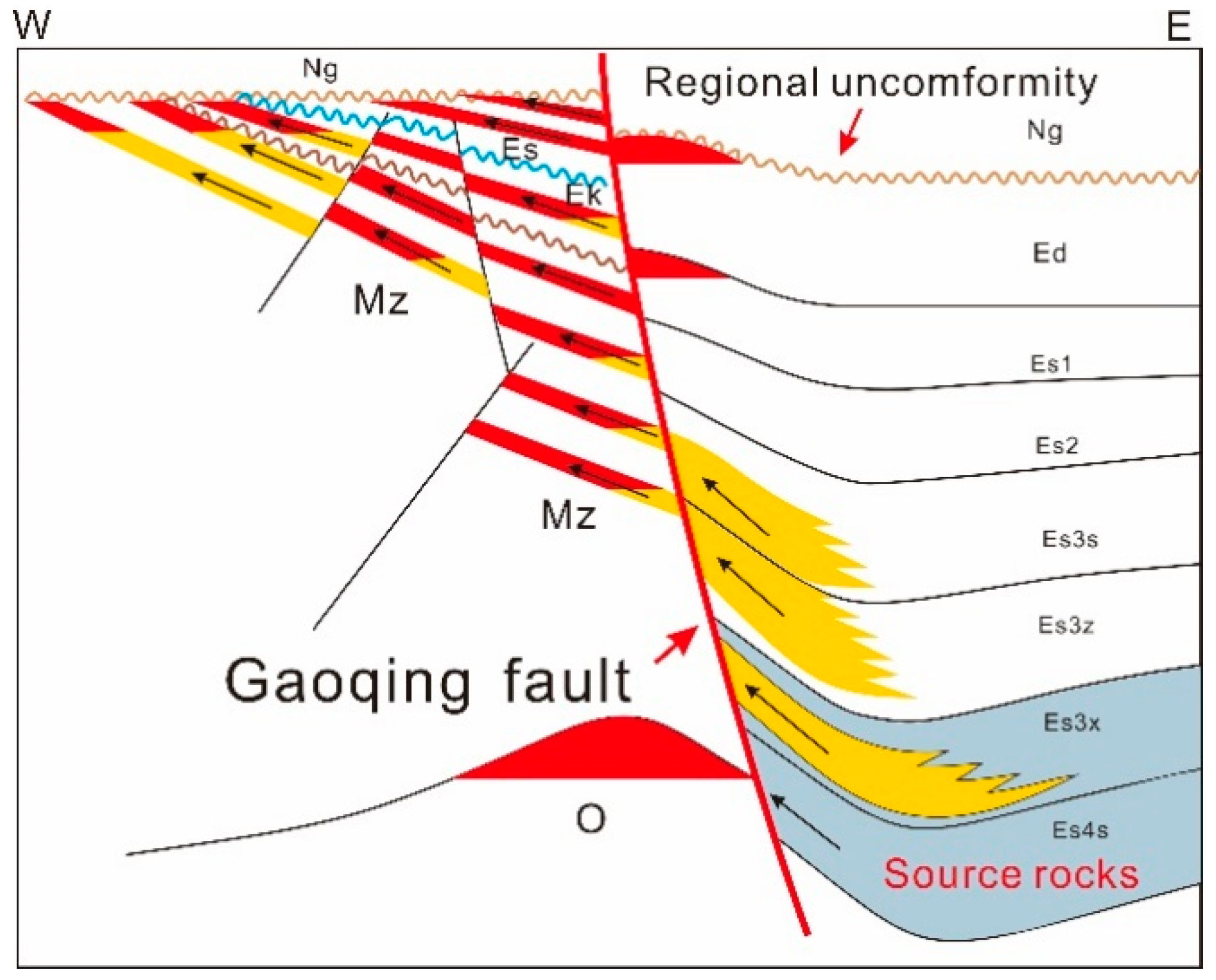
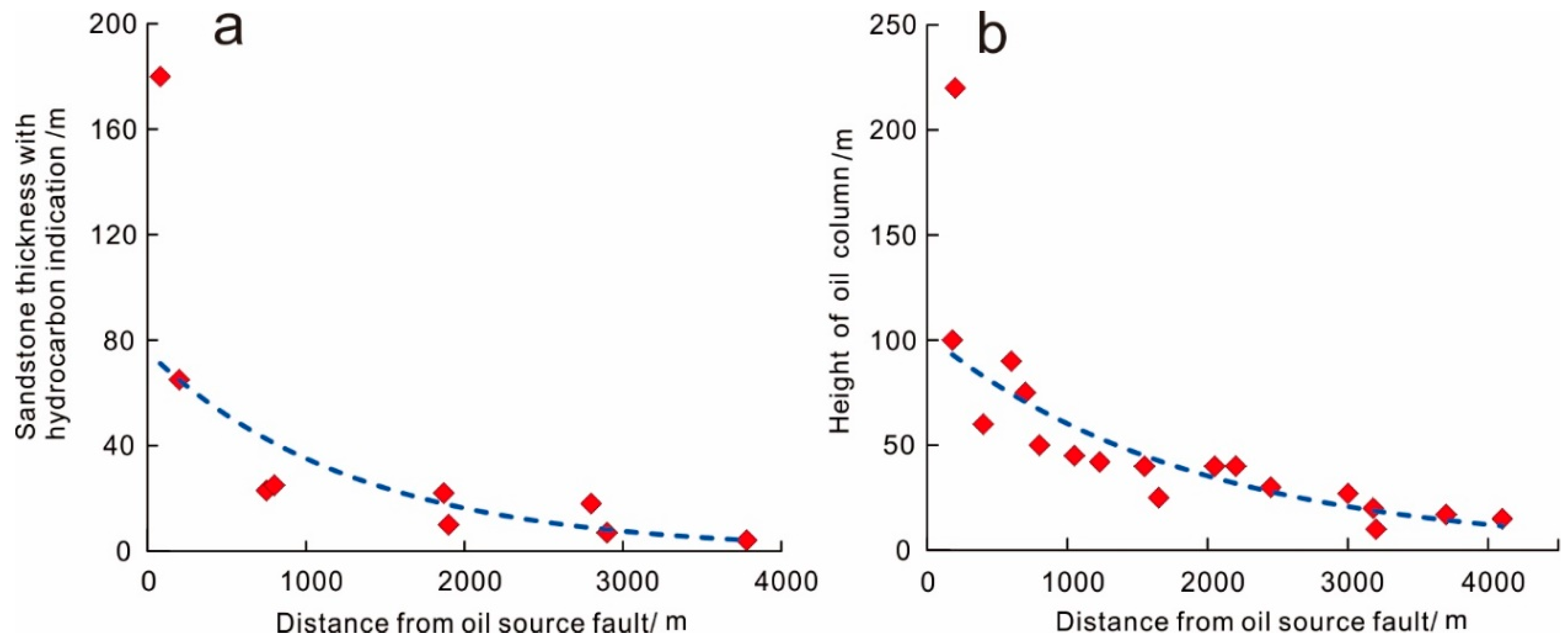
| Component | Min | Max | Average |
|---|---|---|---|
| Detrital grains | |||
| Quartz (vol. %) | 22 | 51 | 36 |
| Potassium feldspars (vol. %) | 10 | 25 | 17 |
| Plagioclase feldspars (vol. %) | 5 | 30 | 19 |
| Total of rock fragments (vol. %) | 15 | 56 | 27 |
| Volcanic lithic fragments (vol. %) | 5 | 30 | 13 |
| Metamorphic lithic fragments (vol. %) | 2 | 26 | 13 |
| Sedimentary lithic fragments (vol. %) | 1 | 13 | 1 |
| Mica (vol. %) | 0 | 2 | 0 |
| Chert (vol. %) | 0 | 3 | 0 |
| Matrix (vol. %) | 0 | 40 | 6 |
| Diagenetic components | |||
| Calcite (vol. %) | 0 | 25 | 3 |
| Ferroan-calcite (vol. %) | 0 | 28 | 3 |
| Dolomite (vol. %) | 0 | 2 | 0 |
| Ferroan-dolomite (vol. %) | 0 | 7 | 0 |
| Quartz overgrowths (vol. %) | 0 | 1.5 | 0 |
| Clay minerals (vol. %) | 4 | 23 | 8 |
| Porosity | |||
| Primary porosity (vol. %) | 0 | 8.23 | 1 |
| Secondary porosity (vol. %) | 0 | 14.24 | 3 |
| Grain grade | Min | Max | Ave |
|---|---|---|---|
| Coarse sand (%) | 0 | 20.6 | 4.77 |
| Medium sand (%) | 0 | 27.4 | 23.38 |
| Fine sand (%) | 0 | 26.3 | 38.33 |
| Silty sand (%) | 0 | 40 | 26.47 |
| Clay (%) | 1 | 36 | 7.05 |
| Medium grain size (μm) | 50 | 690 | 198 |
| Sorting coefficient | 1.31 | 3.93 | 1.71 |
© 2020 by the authors. Licensee MDPI, Basel, Switzerland. This article is an open access article distributed under the terms and conditions of the Creative Commons Attribution (CC BY) license (http://creativecommons.org/licenses/by/4.0/).
Share and Cite
Yang, S.; Wang, Y.; Zhang, S.; Wang, Y.; Zhang, Y.; Zhao, Y. Controls on Reservoirs Quality of the Upper Jurassic Mengyin Formation Sandstones in Dongying Depression, Bohai Bay Basin, Eastern China. Energies 2020, 13, 646. https://doi.org/10.3390/en13030646
Yang S, Wang Y, Zhang S, Wang Y, Zhang Y, Zhao Y. Controls on Reservoirs Quality of the Upper Jurassic Mengyin Formation Sandstones in Dongying Depression, Bohai Bay Basin, Eastern China. Energies. 2020; 13(3):646. https://doi.org/10.3390/en13030646
Chicago/Turabian StyleYang, Shaochun, Ya Wang, Shiqi Zhang, Yongchao Wang, Yifan Zhang, and Yongfu Zhao. 2020. "Controls on Reservoirs Quality of the Upper Jurassic Mengyin Formation Sandstones in Dongying Depression, Bohai Bay Basin, Eastern China" Energies 13, no. 3: 646. https://doi.org/10.3390/en13030646
APA StyleYang, S., Wang, Y., Zhang, S., Wang, Y., Zhang, Y., & Zhao, Y. (2020). Controls on Reservoirs Quality of the Upper Jurassic Mengyin Formation Sandstones in Dongying Depression, Bohai Bay Basin, Eastern China. Energies, 13(3), 646. https://doi.org/10.3390/en13030646





